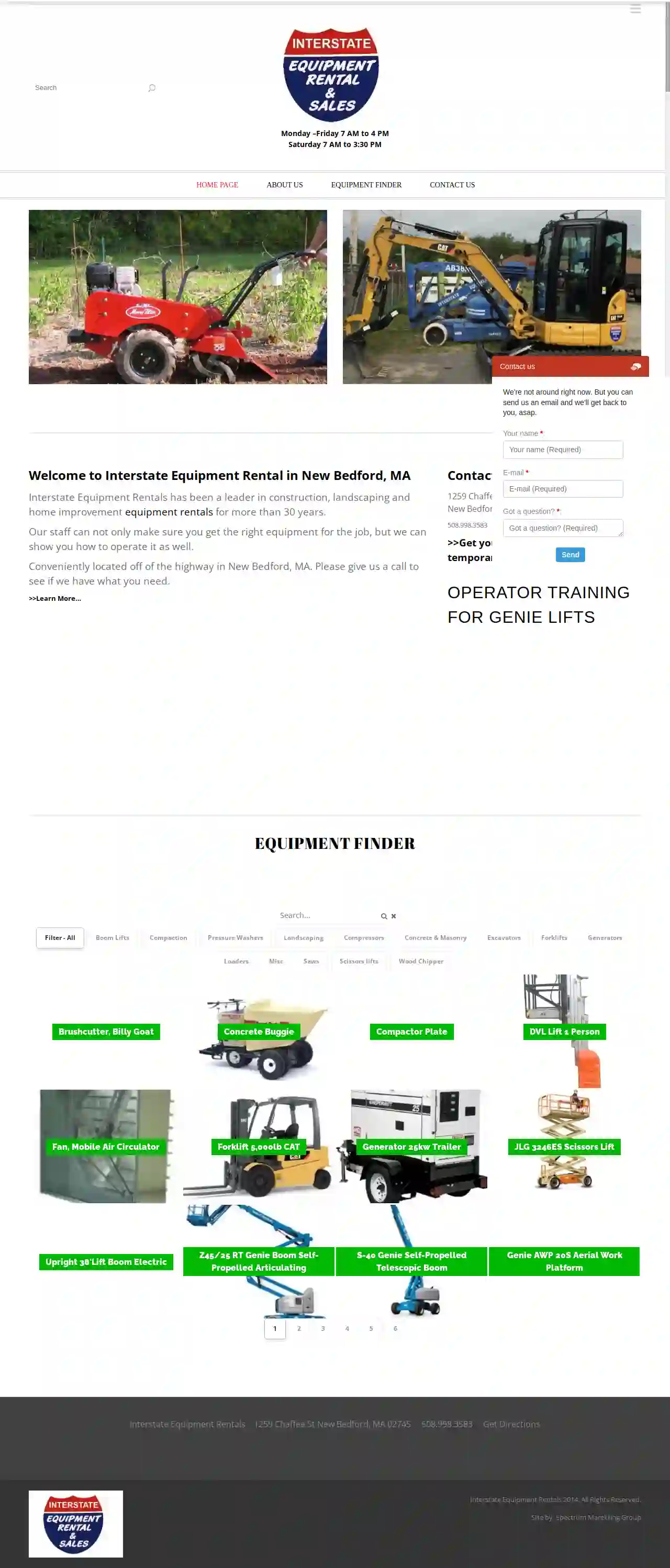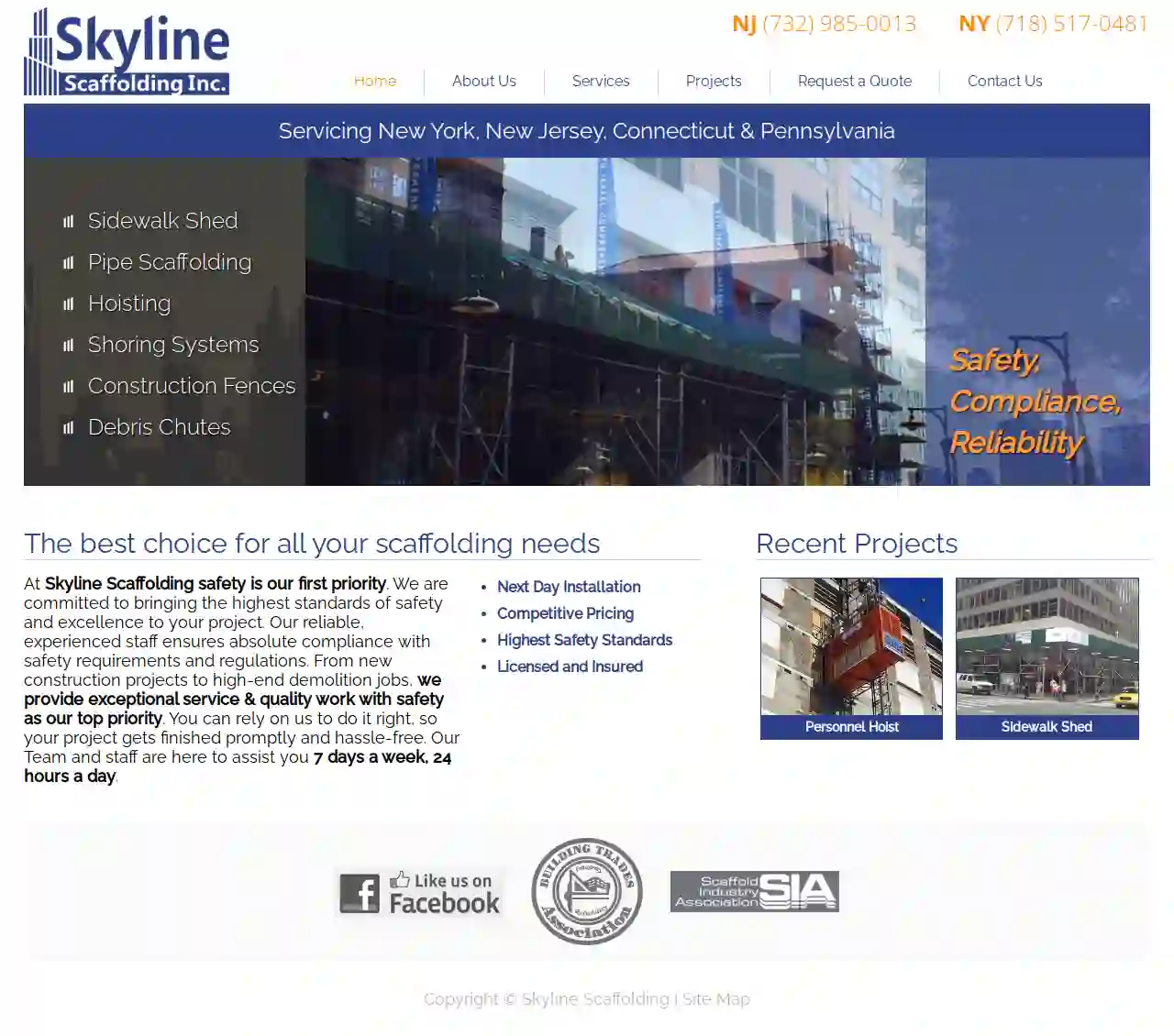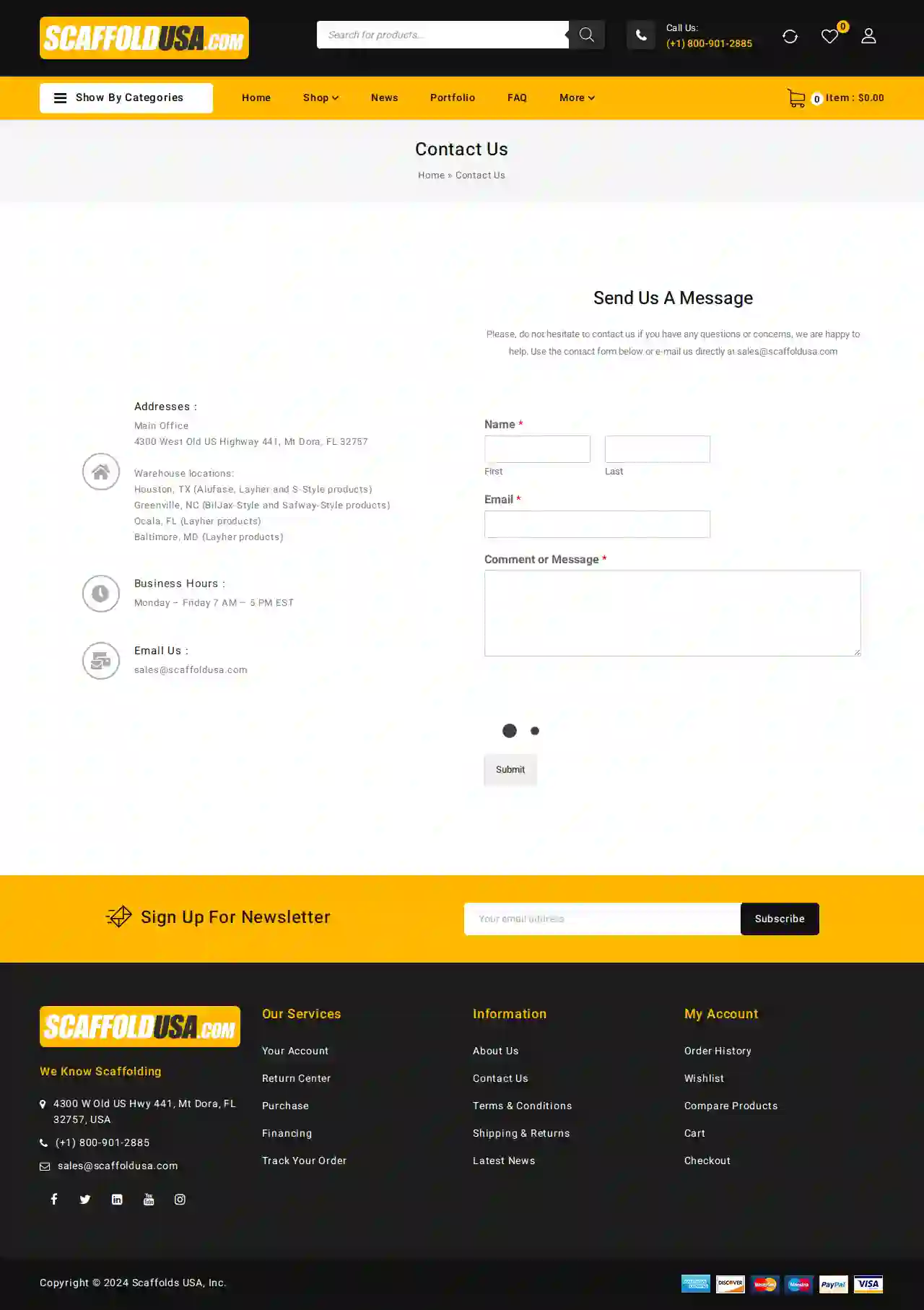Scaffolding Rental St. Albans
Top 10 Rent Scaffolding in St. Albans
Receive multiple Rent Scaffolding quotes for your project today! Compare profiles, reviews, accreditations, portfolio, etc... and choose the best offer.

Lynn Ladder & Scaffolding Co., Inc.
3.813 reviewsLynn, MA, USLynn Ladder was founded in 1946 by Bernie Kline. Bernie’s mission was to provide Ladders and Scaffolding to contractors in the New England area. Today, the third generation of Kline’s continue to pursue that goal across the Eastern United States. Service and quality are paramount in this endeavor. At each of the Lyn-Lad companies, we strive to provide each of our customers with reasonably priced, high quality products in a timely manner.
- Services
- Why Us?
- Accreditations
- Gallery
Get Quote
Interstate Equipment Rental & Sales
4.327 reviews1259 Chaffee St, New Bedford, 02745, USWelcome to Interstate Equipment Rental in New Bedford, MA. Interstate Equipment Rentals has been a leader in construction, landscaping and home improvement equipment rentals for more than 30 years. Our staff can not only make sure you get the right equipment for the job, but we can show you how to operate it as well. Conveniently located off of the highway in New Bedford, MA. Please give us a call to see if we have what you need.
- Services
- Why Us?
- Gallery
Get Quote
Skyline Scaffolding Group, Inc.
4.49 reviews740 Ramsey Avenue, Hillside, 07205, USAt Skyline Scaffolding, safety is our top priority. We are committed to bringing the highest standards of safety and excellence to your project. Our reliable, experienced staff ensures absolute compliance with safety requirements and regulations. From new construction projects to high-end demolition jobs, we provide exceptional service & quality work with safety as our top priority. We have over 25 years of experience in the field of scaffolding and bring that experience to your project. We are passionate about what we do and look for ways to provide the best possible service to our clients. For our customer’s convenience, we provide all of our services to New York, New Jersey, Pennsylvania, and Connecticut.
- Services
- Why Us?
- Accreditations
- Our Team
- Gallery
Get Quote
Johnson Farm & Garden, Hardware & Rental
4.7406 reviews1442 VT Route 15, Johnson, 05656, USWelcome to Johnson Farm & Garden, Hardware and Rental, a family-owned business rooted in Vermont. Our 25,000 sq. foot store is stocked with a wide selection of products, including clothing and footwear, camping equipment, pet food and supplies, garden and growing products, and a toy department. We're also the largest Milwaukee Tool Retailer & Authorized Repair Center in Vermont, offering equipment rentals for projects of all sizes. Located in the picturesque town of Johnson, Vermont, we're just 30 minutes from Stowe, 60 minutes from Burlington, and 15 minutes from Smuggs'. Our team is committed to providing unbeatable selection and exceptional customer service. We're locally owned and operated, and we're proud to be a part of the Vermont community. Come visit us today and experience the difference for yourself!
- Services
- Why Us?
- Accreditations
- Our Team
- Testimonials
- Gallery
Get Quote
Atlas Scaffolding & Equipment
51 reviewsWarwick, RI, 80 Gilbane Street, 02886, USAtlas Scaffolding & Equipment is a full-service scaffolding, shoring, and trash chute equipment rentals, sales, installation, and dismantling services company. Established in 1997, they cater to contractors, municipalities, and industrial customers throughout Rhode Island, Southeastern Massachusetts, and parts of Connecticut. Their main facility is located at 80 Gilbane Street, Warwick, RI. Known for their excellent safety record, quick and responsive service, free estimates, full insurance, strict OSHA compliance, and membership in the SIA, Atlas Scaffolding is a trusted name in the industry.
- Services
- Why Us?
- Accreditations
- Our Team
- Testimonials
- Gallery
Get Quote
The Scaffold Warehouse
New York, USWelcome to The Scaffold Warehouse, your one-stop-shop for all your scaffolding needs. We take pride in our excellent customer service, large scaffolding inventory, and the ability to assist you with all your scaffolding projects. Our team of experts can help you determine what scaffolding works best for the project you're working on. We offer a wide range of scaffolding products, including frame scaffolding, rolling scaffold towers, non-rolling scaffold towers, tube & clamp scaffolding, caster wheels, heavy duty post shores, construction shoring and system equipment. Our products are of the highest quality and are designed to meet your specific needs. Whether you're a contractor, builder, or DIY enthusiast, we have the right scaffolding solution for you. Contact us today to learn more about our products and services.
- Services
- Why Us?
- Gallery
Get Quote
Scaffold Partners
Waterbury, USScaffold Partners specializes in connecting investors to well-vetted self-storage investment opportunities that deliver consistent financial returns. The self-storage industry is a $44 billion industry that has experienced exponential growth in recent years, averaging annual returns of 17.26%. Unlike other asset classes, the self-storage industry is highly fragmented, with the public REITs owning less than 40% of the market. This leaves the majority of properties in the hands of smaller operators, creating tremendous acquisition potential when compared to other real estate asset classes. Fundamentals in this sector are strong, and the self-storage market promises long term expansion and success. New opportunities – for example storing large recreational items and technology – are forecast to carry forward consumer demand and bring in new demographics in coming years.
- Services
- Why Us?
- Accreditations
- Gallery
Get Quote
Scaffold USA
4300 W Old US Hwy 441, Mt Dora, FL 32757, FL, 32757, USScaffolds USA, Inc. is a leading provider of scaffolding solutions, offering a wide range of products including Alufase, Layher, and BilJax style scaffolding. With warehouses in Houston, TX, Greenville, NC, and Ocala, FL, the company serves customers nationwide. Their commitment to quality, customer service, and competitive pricing sets them apart in the industry. The company's mission is to provide safe, reliable, and affordable scaffolding solutions to meet the needs of construction, renovation, and maintenance projects.
- Services
- Why Us?
- Accreditations
- Our Team
- Testimonials
- Gallery
Get Quote
Lanco Scaffolding, Inc.
32 reviews123 Main St, Boston, MA, 02101, USLanco Scaffolding Inc. is a reputable scaffolding contractor and rental service provider, specializing in the installation, maintenance, and dismantling of various scaffolding structures. With a team of experienced professionals, we prioritize safety and efficiency in all our projects, ensuring that every project is completed safely and within budget. We offer a wide range of scaffolding options and rental rates that are competitive and affordable, making us the top choice for scaffolding in the New England area.
- Services
- Why Us?
- Accreditations
- Our Team
- Testimonials
- Gallery
Get Quote
LaValley Building Supply
4152 reviewsLynn, USFor 60 years, LaValley Building Supply has been serving the New England area with building materials, one satisfied customer at a time. Our expert project professionals will work alongside you every step of the way to make sure your project is done right the first time. We deliver housing materials and services for your home. From bathrooms to windows and doors, we have everything you need to transform your home.
- Services
- Why Us?
- Gallery
Get Quote
Over 2,353+ Scaffolding Contractors onboarded
Our scaffolding companies operate in St. Albans & beyond!
ScaffoldingHQ has curated and vetted Top Scaffolding Companies arround St. Albans. Find a reliable business today.
Frequently Asked Questions About Scaffolding Rental
- Daily: For short-term tasks or smaller projects.
- Weekly: A common option for projects lasting a few days to a week.
- Monthly: Suitable for larger or longer-term projects.
- Custom Duration: Some companies may offer custom rental periods to fit your specific timeframe.
- Underestimating Scaffolding Needs: Accurately assess the required scaffolding size and type.
- Not Comparing Quotes: Get quotes from multiple rental companies to find the best deal.
- Ignoring Safety: Prioritize safety by hiring qualified erectors and ensuring workers follow safety protocols.
- Overlooking Permits: Obtain any necessary permits before erecting scaffolding.
- Not Inspecting the Scaffolding: Carefully inspect the scaffolding upon delivery and before each use.
- Modifying Scaffolding without Authorization: Never alter the scaffolding without consulting the rental company or an engineer.
- Stop Using It Immediately: Do not attempt to use damaged scaffolding. It could be unsafe.
- Contact the Rental Company: Notify the scaffolding rental company about the damage as soon as possible.
- Document the Damage: Take photos or videos of the damage for documentation. The rental agreement should outline the procedures for handling damaged equipment. You may be responsible for repair or replacement costs, depending on the circumstances and the terms of the agreement.
How long can you rent scaffolding for?
What are some common mistakes to avoid when renting scaffolding?
What happens if the scaffolding is damaged during my rental period?
What is the maximum height of scaffolding?
How long can you rent scaffolding for?
- Daily: For short-term tasks or smaller projects.
- Weekly: A common option for projects lasting a few days to a week.
- Monthly: Suitable for larger or longer-term projects.
- Custom Duration: Some companies may offer custom rental periods to fit your specific timeframe.
What are some common mistakes to avoid when renting scaffolding?
- Underestimating Scaffolding Needs: Accurately assess the required scaffolding size and type.
- Not Comparing Quotes: Get quotes from multiple rental companies to find the best deal.
- Ignoring Safety: Prioritize safety by hiring qualified erectors and ensuring workers follow safety protocols.
- Overlooking Permits: Obtain any necessary permits before erecting scaffolding.
- Not Inspecting the Scaffolding: Carefully inspect the scaffolding upon delivery and before each use.
- Modifying Scaffolding without Authorization: Never alter the scaffolding without consulting the rental company or an engineer.
What happens if the scaffolding is damaged during my rental period?
- Stop Using It Immediately: Do not attempt to use damaged scaffolding. It could be unsafe.
- Contact the Rental Company: Notify the scaffolding rental company about the damage as soon as possible.
- Document the Damage: Take photos or videos of the damage for documentation. The rental agreement should outline the procedures for handling damaged equipment. You may be responsible for repair or replacement costs, depending on the circumstances and the terms of the agreement.